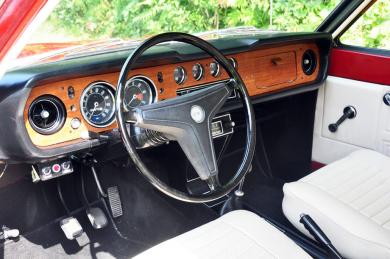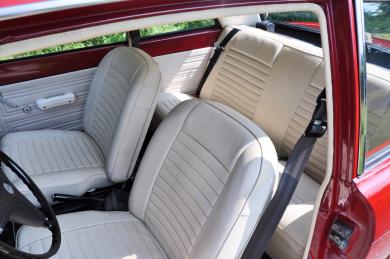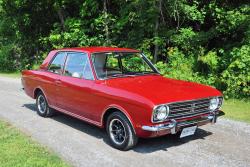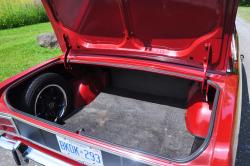  1969 Ford Cortina GT dashboard & cabin. Click image to enlarge |
One more thing about the Cortina interior is that it’s very spacious. You might wonder why today’s larger cars can seem cosy inside, but you’re looking at much thicker doors, airbags, massive pillars, fat steering wheels, complex convenience accessories and heavily upholstered seats that all take space (unfortunately this Cortina GT is missing its distinctive front seat head restraints, likely unavailable now). Look at the Cortina’s thin A-pillars and doors, the lack of map pockets and storage, and the amount of glass (outward visibility is abundant in all directions) in comparison. And at a stated 594 litres the trunk is huge. A 2015 Ford Fusion offers 453L, a Ford Taurus 563L, but at 4,267 millimetres in length, the Cortina is actually shorter than a Ford Focus sedan (4,534 mm) which offers only 374L of trunk space. Now I haven’t actually corroborated the Cortina’s claims of a 594L trunk, but I can tell you it’s big.
  1969 Ford Cortina GT & 1969 Ford Cortina GT trunk. Click image to enlarge |
Which is why driving around in a Cortina makes a lot of sense today. It easily accommodates four adults, has lots of room for cargo, doesn’t use much fuel, turns on a dime, is very easy to park and is peppy enough to handle modern highways. The bonus is that the GT offers a raspy exhaust note under acceleration, a butter smooth gearshift and good handling (supplemented, I’m sure, by the presence of urethane bushings in this example).
Behind the wheel (such a skinny thing) you’re immediately aware of how airy it is inside. Yes, it’s an off-white interior which contributes, but except for the narrow pillars you almost have an uninterrupted 360-degree view around the car. The gauges are easy to see and read, there’s a manual choke, the horn is part of the turn signal stalk (you push it to sound the horn), ignition as mentioned on the left (if it doesn’t start first time, you have to turn it fully off, then try again like today’s Volkswagens), seats are comfortable, there are factory three-point safety belts (a progressive feature), clock mounted down low, and that rather crudely rendered wood dash. The engine typically fires up willingly and acceleration feels brisker than it is (about 12 seconds 0-100 km/h. The four-speed transmission shifts easily but gearbox whines (not uncommon, apparently). I think the design’s held up pretty well for a 45-year old car.
There are a couple of negatives when driving this car, though. First of all, Cortinas didn’t get rack and pinion steering. Instead they were fitted with a steering box and it imparts a heavy feel when taking corners. You adjust, but it’s nowhere near as sharp, immediate or precise as a rack-and-pinion setup, requiring more steering input than you may be used to. It’s not power-assisted, either, which can make maneuvering in close quarters a chore. The brakes (front disc, rear drum) are power assisted, however, and pull the 921-kg car down from speed in short order.
Another negative, for me at least, is that with the seat positioned to comfortably steer and access the pedals, I can barely reach the gearshift without reaching. While it may be a close-ratio gearbox, it’s not a particularly short-throw shifter, and the shifter is too far forward to easily engage first and third. This may just be a feature of this particular engine-transmission combination. I know that Morgan used a predecessor of this power train in its cars and they (Morgan) actually made available a remote kit to move the gearshift closer to the driver.
Finally, those wheels are just too small, aren’t they? At 13 inches in diameter I guess they were modern enough for the era, but today their diminutive size is one of the first things noticed about this car. A nice set of silver 14- or 15-inch wheels in the same Minilite style would brighten the exterior and would still be “period correct,” I think.
Otherwise, this is a great little car to drive, and it turns out that many people fondly remember them. We even got a station wagon version in Canada — the Estate — although I don’t think I’ve ever seen one. But the GT just picks up and goes, turning heads with its boxy vintage look. “Is it a Toyota?” “Looks like a Datsun 510.” “Hey, that thing looks like new!”
1969 Ford Cortina GT. Now you know.









